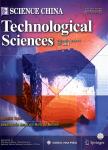Numerical simulation on drag reduction of revolution body through bionic riblet surface
Numerical simulation on drag reduction of revolution body through bionic riblet surface作者机构:Key Laboratory of Bionics EngineeringMinistry of EducationJilin UniversityChangchun 130022China College of AgricultureDepartment of PhysicsJilin UniversityChangchun 130062China
出 版 物:《Science China(Technological Sciences)》 (中国科学(技术科学英文版))
年 卷 期:2010年第53卷第11期
页 面:2954-2959页
核心收录:
学科分类:08[工学] 09[农学] 0901[农学-作物学] 0836[工学-生物工程] 090102[农学-作物遗传育种]
基 金:supported by the Base Platform Construction Project of Jilin University Basic Scientific Research (Grant No 421060202466) the Technology Development Plan Project of Jilin Province (Grant No 20096032) the Youth Research Foundation of the Jilin University Agron-omy Faculty (Grant No 4305050102k7) the Key Program of National Natural Science Foundation of China (Grant No 50635030) the Ma-jor Program of the Science and Technology Development of Jilin Province (Grant No 09ZDGG001)
主 题:bionic engineering riblet surface drag reduction numerical simulation revolution body
摘 要:Numerical simulations of flow fields on the bionic riblet and the smooth revolution bodies were performed based on the SST k-ω turbulence model in order to explain the mechanisms of the skin friction drag reduction, base drag reduction on the riblet surface, and flow control behaviors of riblet surface near the wall. The simulation results show that the riblet surface arranged on the rearward of the revolution body can reduce the skin friction drag by 8.27%, the base drag by 9.91% and the total drag by 8.59% at Ma number 0.8. The riblet surface reduces the skin friction drag by reducing the velocity gradient and turbulent intensity, and reduces the base drag by weakening the pumping action on the dead water region which behind the body of revolution caused by the external flow. The flow control behavior on boundary layer shows that the riblet surface can cut the low-speed flow near the wall effectively, and restrain the low-speed flow concentrating in span direction, thus weaken the instability of the low speed steaks produced by turbulent flow bursting.



